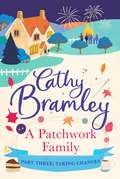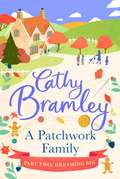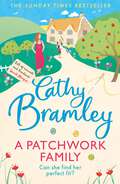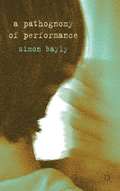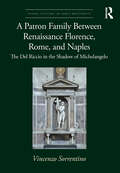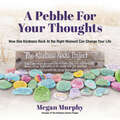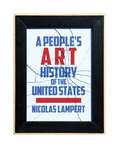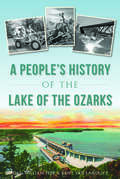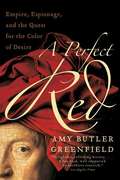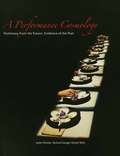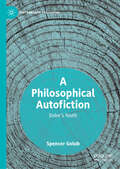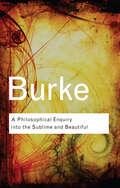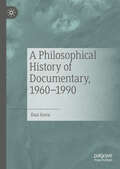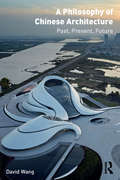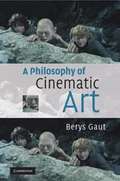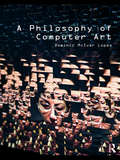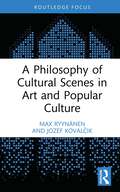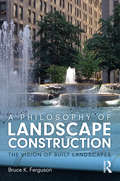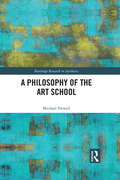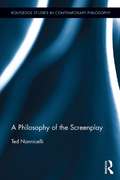- Table View
- List View
A Patchwork Family - Part Three: Taking Chances
by Cathy BramleyThis is part three in an uplifting four-part serial from bestseller Cathy Bramley. After Gina and her friends' attempts at sabotage, the future of The Evergreens still hangs in the balance. To make matters even more complicated, she can now add one sweet kiss to the mix... and another prospective buyer. As the weight of her promise to save the house hangs heavily over her, seeing the children bubbling with joy in a crafting session with the elders lights a fresh fire in her belly.Deep down Gina believes that some risks are worth taking. The question is, does she believe in herself?Return to the village of Barnaby and the world of the bestselling novel, The Lemon Tree Cafe. A Patchwork Family is a heartwarming novel told in four parts, following the challenges and triumphs faced by Gina Moss as she swaps an easy life for a happy one. This is the third part. *****Praise for Cathy Bramley from some of your other favourite authors:'Delightful!' Katie Fforde'A page-turner of a story' Milly Johnson'Delightfully warm with plenty of twists and turns' Trisha Ashley'The perfect romantic tale, to warm your heart and make you smile' Ali McNamara
A Patchwork Family - Part Two: Dreaming Big
by Cathy BramleyThis is part two in an uplifting four-part serial from bestseller Cathy Bramley. Gina's array of cheeky companions at Welcome Cottage are the perfect, cheerful reminder that life must go on, however tough it gets. A picnic at The Evergreens gives Gina an exciting idea: what if the house could be a place where the young and old could fit together?But it also brings her closer to Dexter: one of the people behind the sale of the house. As the sparks fly between them, Gina carries on fighting for her friends, her home and her business. The wheels are in motion for an ambitious ploy that is sure to keep The Evergreens from selling - but it might well leave her and Dexter's budding friendship in tatters... Return to the village of Barnaby and the world of the bestselling novel, The Lemon Tree Cafe. A Patchwork Family is a heartwarming novel told in four parts, following the challenges and triumphs faced by Gina Moss as she swaps an easy life for a happy one. This is the second part.*****Praise for Cathy Bramley from some of your other favourite authors:'Delightful!' Katie Fforde'A page-turner of a story' Milly Johnson'Delightfully warm with plenty of twists and turns' Trisha Ashley'The perfect romantic tale, to warm your heart and make you smile' Ali McNamara
A Patchwork Family: An uplifting and heart-warming novel to cosy up with from the Sunday Times bestseller
by Cathy BramleyThe perfect feel-good comfort read to curl up and get cosy with this winter!'A book full of warmth and kindness. I loved it' Sarah Morgan------------------------------------------------Gina Moss is single and proud. She's focused on her thriving childminding business, which she runs from her cottage at the edge of The Evergreens: a charming Victorian home to three elderly residents who adore playing with the kids Gina minds. To Gina, they all feel like family. Then a run-in (literally) with a tall, handsome American stranger gives her the tummy-flutters... Before a tragedy puts her older friends at risk of eviction - and Gina in charge of the battle to save them. The house sale brings her closer to Dexter, one of the owners - and the stranger who set her heart alight.As the sparks fly between them, Gina carries on fighting for her friends, her home and her business. But can she fight for her chance at love - and win it all, too?A Patchwork Family was originally published as a four-part serial. This is the complete story in one package. -------------------------------------------------There is so much love for A Patchwork Family!'A gorgeously romantic comfort read - my favourite Cathy Bramley book yet!' Rachael Lucas, author of The Telephone Box Library'Warmth, love, family dynamics and sparky drama - vintage Cathy Bramley!' Sue Moorcroft, bestselling author of One Summer in Italy'A warm hug of a book' Phillipa Ashley, bestselling author of A Perfect Cornish Christmas------------------------------------------------Praise for Cathy Bramley from some of your other favourite authors:'Delightful!' Katie Fforde'A page-turner of a story' Milly Johnson'Delightfully warm with plenty of twists and turns' Trisha Ashley'The perfect romantic tale, to warm your heart and make you smile' Ali McNamara
A Patchwork Family: An uplifting and heart-warming novel to cosy up with from the Sunday Times bestseller
by Cathy BramleyThe perfect feel-good comfort read to curl up and get cosy with this winter!''A book full of warmth and kindness. I loved it'' Sarah Morgan------------------------------------------------Gina Moss is single and proud. She''s focused on her thriving childminding business, which she runs from her cottage at the edge of The Evergreens: a charming Victorian home to three elderly residents who adore playing with the kids Gina minds. To Gina, they all feel like family. Then a run-in (literally) with a tall, handsome American stranger gives her the tummy-flutters... Before a tragedy puts her older friends at risk of eviction - and Gina in charge of the battle to save them. The house sale brings her closer to Dexter, one of the owners - and the stranger who set her heart alight.As the sparks fly between them, Gina carries on fighting for her friends, her home and her business. But can she fight for her chance at love - and win it all, too?A Patchwork Family was originally published as a four-part serial. This is the complete story in one package. -------------------------------------------------There is so much love for A Patchwork Family!''A gorgeously romantic comfort read - my favourite Cathy Bramley book yet!'' Rachael Lucas, author of The Telephone Box Library''Warmth, love, family dynamics and sparky drama - vintage Cathy Bramley!'' Sue Moorcroft, bestselling author of One Summer in Italy''A warm hug of a book'' Phillipa Ashley, bestselling author of A Perfect Cornish Christmas------------------------------------------------Praise for Cathy Bramley from some of your other favourite authors:''Delightful!'' Katie Fforde''A page-turner of a story'' Milly Johnson''Delightfully warm with plenty of twists and turns'' Trisha Ashley''The perfect romantic tale, to warm your heart and make you smile'' Ali McNamara
A Pathognomy of Performance
by Simon BaylyExploring the themes of the event, ephemerality and democracy that mark the encounter between performance and philosophy, this original study elaborates fresh perspectives on the experiences of undoing, fiasco and disaster that shadow both the both stage and everyday life.
A Patron Family Between Renaissance Florence, Rome, and Naples: The Del Riccio in the Shadow of Michelangelo (ISSN)
by Vincenzo SorrentinoThis book tells the story of the Del Riccio family in Florence in the early modern period, investigating the cultural mediations fostered by the family between Florence, Rome, and Naples, as well as shedding light on the intellectual and social exchanges between different regions of Italy and on the creation of foreign nations within the main Italian cities. These social and cultural dimensions are further explored through the study of the obsessive persistence of the family’s relationship with Michelangelo Buonarroti, exhibited both publicly, in the Florentine and Neapolitan family chapels, and privately in their homes. The main achievement of this study is to move the focus from the ruling power, the Medici family and the immediate members of their court, to a Florentine middle-class family and its social mobility: this shift from the conventional narrative to a distributed microhistory is fundamental to better assess the use of images and artworks in early modern Florence and abroad. The aesthetic and stylistic choices in the use of art and art display made by the Del Riccio reveal a deep awareness of the substantial differences in taste and meaning between different cities of the Italian peninsula. The book will be of interest to scholars working in art history, visual culture, and Renaissance studies.
A Patron Family Between Renaissance Florence, Rome, and Naples: The Del Riccio in the Shadow of Michelangelo (Visual Culture in Early Modernity)
by Vincenzo SorrentinoThis book tells the story of the Del Riccio family in Florence in the early modern period, investigating the cultural mediations fostered by the family between Florence, Rome, and Naples, as well as shedding light on the intellectual and social exchanges between different regions of Italy and on the creation of foreign nations within the main Italian cities. These social and cultural dimensions are further explored through the study of the obsessive persistence of the family’s relationship with Michelangelo Buonarroti, exhibited both publicly, in the Florentine and Neapolitan family chapels, and privately in their homes. The main achievement of this study is to move the focus from the ruling power, the Medici family and the immediate members of their court, to a Florentine middle class family and its social mobility: this shift from the conventional narrative to a distributed microhistory is fundamental to better assess the use of images and artworks in early modern Florence and abroad. The aesthetic and stylistic choices in the use of art and art display made by the Del Riccios reveal a deep awareness of the substantial differences in taste and meaning between different cities of the Italian peninsula. The book will be of interest to scholars working in art history, visual culture, and Renaissance studies.
A Pattern Language: Towns, Buildings, Construction
by Christopher Alexander Sara Ishikawa Murray SilversteinThe second of three books published by the Center for Environmental Structure to provide a "working alternative to our present ideas about architecture, building, and planning," A Pattern Language offers a practical language for building and planning based on natural considerations. The reader is given an overview of some 250 patterns that are the units of this language, each consisting of a design problem, discussion, illustration, and solution. By understanding recurrent design problems in our environment, readers can identify extant patterns in their own design projects and use these patterns to create a language of their own. Extraordinarily thorough, coherent, and accessible, this book has become a bible for homebuilders, contractors, and developers who care about creating healthy, high-level design.
A Pebble for Your Thoughts: How One Kindness Rock At the Right Moment Can Change Your Life
by Megan Murphy#1 New Release in Rocks & Minerals - Kindness Rocks as seen on the Today showFans of The Kindness Challenge and the Chicken Soup For The Soul books will love A Pebble for Your Thoughts.A rock for each kindness. It all started with a single stone on a beach in Cape Cod and now spans the globe. The Kindness Rocks Project, founded by Megan Murphy, is based on the profound truth that one kind message at the right moment can change someone’s day, their outlook, and their whole life. The project has become an international grassroots movement! The messages on these thoughtful pebbles take many forms: gratitude, affirmations, encouragement, offers of hope, all signposts along the way for someone to find at exactly the right time.Kindness matters. Now more than ever, people are longing for kindness and connection. During these uncertain times, daily news reports focus on disturbing events of terrorism, gun violence, senseless murders and political bickering. We are bombarded with images that evoke fear and hostility. A Pebble for Your Thoughts provides a positive counteraction to all this negativity.Learn to be kinder to yourself and others. Sometimes, all it takes is just one simple positive message to change your perspective and that is what this book aims to do. Through visual photos of inspirational Kindness rocks, readers can connect the meaning of the rock to their life situations or circumstances. Instructions on how to create your own rock are also included.What people will learn from this book:How to cultivate compassion and connectionHow to grow through hard timesAffirmations to boost self-esteem and offer hope in hard timesHow one act of kindness can change a lifeA completely unique kind of art therapy for healing and helpingThe power of kindness in one small pebble
A People's Art History of the United States
by Nicolas LampertMost people outside of the art world view art as something that is foreign to their experiences and everyday lives. A People's Art History of the United States places art history squarely in the rough-and-tumble of politics, social struggles, and the fight for justice from the colonial era through the present day.Author and radical artist Nicolas Lampert combines historical sweep with detailed examinations of individual artists and works in a politically charged narrative that spans the conquest of the Americas, the American Revolution, slavery and abolition, western expansion, the suffragette movement and feminism, civil rights movements, environmental movements, LGBT movements, antiglobalization movements, contemporary antiwar movements, and beyond.A People's Art History of the United States introduces us to key works of American radical art alongside dramatic retellings of the histories that inspired them. Stylishly illustrated with over two hundred images, this book is nothing less than an alternative education for anyone interested in the powerful role that art plays in our society.
A People's History of the Lake of the Ozarks
by Dan William Peek Kent Van LanduytFor tourists, the beautiful Lake of the Ozarks must seem in complete harmony with the natural order of its surroundings. Even lifelong natives can struggle to imagine a time when the reservoir created by the Bagnell Dam didn't exist. But beneath the placid waters of the lake that draws bustling visitors to its shores lies the drama of a remote Ozark community suddenly thrust into an urban world. True locals Dan William Peek and Kent Van Landuyt piece together the fascinating story of how that community adapted to the lake that redefined their home.
A Perfect Fit: How Lena “Lane” Bryant Changed the Shape of Fashion
by Mara RockliffDiscover how the Lane Bryant clothing brand changed the way we buy clothes forever by celebrating bodies of all shapes and sizes in this inclusive picture book biography of a Lithuanian immigrant with a brilliant eye for fashion and business. With stunning artwork from Sibert medalist Juana Martinez-Neal.Lena came to America with nothing but a dream—and an exceptional ability to drape and snip and stitch. She never used a pattern or a tape measure, but every dress she sewed turned out to be a perfect fit.Then, one day, a customer presented her with a new challenge. Could she design a stylish, comfortable gown for a body shape that did not meet the current standards of fashion?Lena took the challenge. Under the company name Lane Bryant, she became famous for flattering and modish clothing designed for all different shapes and sizes. The world of fashion would never be the same.
A Perfect Red
by Amy Butler GreenfieldA Perfect Red recounts the colorful history of cochineal, a legendary red dye that was once one of the world's most precious commodities. Treasured by the ancient Mexicans, cochineal was sold in the great Aztec marketplaces, where it attracted the attention of the Spanish conquistadors in 1519. Shipped to Europe, the dye created a sensation, producing the brightest, strongest red the world had ever seen. Soon Spain's cochineal monopoly was worth a fortune. Desperate to find their own sources of the elusive dye, the English, French, Dutch, and other Europeans tried to crack the enigma of cochineal. Did it come from a worm, a berry, a seed? Could it be stolen from Mexico and transplanted to their own colonies? Pirates, explorers, alchemists, scientists, and spies -- all joined the chase for cochineal, a chase that lasted more than three centuries. A Perfect Red tells their stories -- true-life tales of mystery, empire, and adventure, in pursuit of the most desirable color on earth.
A Performance Cosmology: Testimony from the Future, Evidence of the Past
by Richard Gough Judie Christie Daniel WattExploring thirty years of work by The Centre for Performance Research (CPR), A Performance Cosmology explores the future challenges of performance and theatre through a diverse and fascinating series of interviews, testimonies and perspectives from leading international theatre practitioners and academics. Contributors include: Philip Auslander, Rustom Bharucha, Tim Etchells, Jane Goodall, Guillermo Gomez-Pena, Jon Mckenzie, Claire MacDonald, Susan Melrose, Alphonso Lingis, Richard Schechner, Rebecca Schneider, Edward Scheer, and Freddie Rokem. A Performance Cosmology is structured as a travelogue through a matrix of strategic, imaginary, interdisciplinary field stations. This innovative framework enables readings which disrupt linearity and afford different forms of thematic engagement. The resulting volume opens entirely new vistas on the old, new, and as yet unimagined, worlds of performance.
A Philosophical Autofiction: Dolor's Youth (Performance Philosophy)
by Spencer GolubThis is a book about what becomes of the truth when it succumbs to generational memory loss and to the fictions that intervene to cause and fill the gaps. It is a book about the impossibility of writing an autobiography when there is a prepossessing cultural and familial 'we' interfering with the 'I' and an 'I' that does not know itself as a self, except metastatically — as people and characters it has played but not actually been.A highly original combination of close readings and performative autobiography, this book takes performance philosophy to an alternative next step, by having its ideas read back to it by experience, and through assorted fictions. It is a philosophical thought experiment in uncertainty whose literary, theatrical, and cinematic trappings illustrate and finally become what this uncertainty is, the thought experiment having become the life that was, that came before, and that outlives the 'I am'.
A Philosophical Enquiry Into the Sublime and Beautiful: With An Introductory Discourse Concerning Taste And Several Other Additions (Routledge Classics)
by Edmund BurkeEdited with an introduction and notes by James T. Boulton. 'One of the greatest essays ever written on art.'– The Guardian Edmund Burke’s A Philosophical Enquiry into the Origin of our Ideas of the Sublime and Beautiful is one of the most important works of aesthetics ever published. Whilst many writers have taken up their pen to write of "the beautiful", Burke’s subject here was the quality he uniquely distinguished as "the sublime"—an all-consuming force beyond beauty that compelled terror as much as rapture in all who beheld it. It was an analysis that would go on to inspire some of the leading thinkers of the age, including Immanuel Kant and Denis Diderot. The Routledge Classics edition presents the authoritative text of the first critical edition of Burke’s essay ever published, including a substantial critical and historical commentary. Edmund Burke (1729–1797). A politician, philosopher and orator, Burke lived during a turbulent time in world history, which saw revolutions in America and France that inspired his most famous work, Reflections on the Revolution in France.
A Philosophical History of Documentary, 1895–1959
by Dan GevaThis book presents a chronology of thirty definitions attributed to the word, term, phrase, and concept of “documentary” between the years 1895 and 1959. The book dedicates one chapter to each of the thirty definitions, scrutinizing their idiosyncratic language games from close range while focusing on their historical roots and concealed philosophical sources of inspiration. Dan Geva's principal argument is twofold: first, that each definition is an original ethical premise of documentary; and second, that only the structured assemblage of the entire set of definitions successfully depicts the true ethical nature of documentary insofar as we agree to consider its philosophical history as a reflective object of thought in a perpetual state of being-self-defined: an ethics sui generis.
A Philosophical History of Documentary, 1960-1990
by Dan GevaA Philosophical History of Documentary, 1960–1990 is the second book in a three-volume set. It offers a systematic hermeneutical reading of thirty definitions of Documentary from 1960 to 1990—by then a familiar, already used, and &“abused&” dialectical object of thought and practice. The book progresses chronologically through three decades of ongoing efforts by documentarians, theorists, historians, and philosophers to define Documentary, examining the philosophical foundations, ethical implications, and evolving documentarological sensibilities of these definitions. It also reassesses the intense ontological debates about Documentary, highlighting the discourse's expanding definitional landscape. Building on the first volume, which examined thirty definitions from 1895 to 1959, this work weaves an intricate hermeneutical network of interconnections among all sixty definitions. It further anticipates the third volume, which will analyze forty additional definitions of Documentary from 1991 to the present, offering a comprehensive philosophical history of the evolution of Documentary as both concept and practice.
A Philosophy of Chinese Architecture: Past, Present, Future
by David WangA Philosophy of Chinese Architecture: Past, Present, Future examines the impact of Chinese philosophy on China’s historic structures, as well as on modern Chinese urban aesthetics and architectural forms. For architecture in China moving forward, author David Wang posits a theory, the New Virtualism, which links current trends in computational design with long-standing Chinese philosophical themes. The book also assesses twentieth-century Chinese architecture through the lenses of positivism, consciousness (phenomenology), and linguistics (structuralism and poststructuralism). Illustrated with over 70 black-and-white images, this book establishes philosophical baselines for assessing architectural developments in China, past, present and future.
A Philosophy of Cinematic Art
by Berys GautA Philosophy of Cinematic Art is a systematic study of cinema as an art form, showing how the medium conditions fundamental features of cinematic artworks. It discusses the status of cinema as an art form, whether there is a language of film, realism in cinema, cinematic authorship, intentionalist and constructivist theories of interpretation, cinematic narration, the role of emotions in responses to films, the possibility of identification with characters, and the nature of the cinematic medium. Groundbreaking in its coverage of a wide range of contemporary cinematic media, it analyses not only traditional photographic films, but also digital cinema, and a variety of interactive cinematic works, including videogames. Written in a clear and accessible style, the book examines the work of leading film theorists and philosophers of film, and develops a powerful framework with which to think about cinema as an art.
A Philosophy of Computer Art
by Dominic LopesWhat is computer art? Do the concepts we usually employ to talk about art, such as ‘meaning’, ‘form’ or ‘expression’ apply to computer art? A Philosophy of Computer Art is the first book to explore these questions. Dominic Lopes argues that computer art challenges some of the basic tenets of traditional ways of thinking about and making art and that to understand computer art we need to place particular emphasis on terms such as ‘interactivity’ and ‘user’. Drawing on a wealth of examples he also explains how the roles of the computer artist and computer art user distinguishes them from makers and spectators of traditional art forms and argues that computer art allows us to understand better the role of technology as an art medium.
A Philosophy of Cultural Scenes in Art and Popular Culture (Routledge Focus on Art History and Visual Studies)
by Max Ryynänen Jozef KovalčikThis book seeks to understand culture through the lens of scenes, analyzing them aesthetically and culturally as well as understanding them through the frameworks of gender, social networks, and artworlds. It is common to talk about the cultural and intellectual scenes of early twentieth-century Vienna, the visual art scene of postwar New York, and the music and fashion scene of the swinging London. We often think about artists and works of art as essentially belonging to a certain scene. Scenes might offer a new approach to study what is possible, what is a tradition, and/or to discuss what are the relevant units of contemporary culture for research. The book posits that scenes explain a lot about how the artworld and the cultural field function. Vivienne Westwood, Rene Magritte, Roman Jakobson, Arthur C. Danto, Susan Sontag, James Baldwin, and Didier Eribon are among the figures included in the book, which examines scenes in cities such as Moscow, Bombay, New York, London, Paris, Brussels, Helsinki, and Bratislava. The book will be of interest to scholars working in art history, cultural studies, philosophy, film, literature, and urban studies.
A Philosophy of Landscape Construction: The Vision of Built Spaces
by Bruce FergusonA Philosophy of Landscape Construction outlines a philosophy of values in landscape construction, demonstrating how integral structures, such as pavements and walls, constitute a key element to how people interact with and inhabit the final design. The book discusses how these structures enable, assist and care for people, negotiating between the dynamic processes of site ecosystems and the soil on which they are founded. They articulate spatial, functional, cultural and ecological meanings. Within this theoretical framework, designers will learn to recognize and insert a set of core values into the most technical design stages to reach their full potential. By offering a new perspective on landscape construction, moving away from the exclusively technical characteristics, this book allows landscape architects to realise the ideal vision for their designs. It is abundantly illustrated with examples from which designers can learn both successes and failures and will be an essential companion to any study of built landscapes.
A Philosophy of the Art School (Routledge Research in Aesthetics)
by Michael NewallUntil now, research on art schools has been largely occupied with the facts of particular schools and teachers. This book presents a philosophical account of the underlying practices and ideas that have come to shape contemporary art school teaching in the UK, US and Europe. It analyses two models that, hidden beneath the diversity of contemporary artist training, have come to dominate art schools. The first of these is essentially an old approach: a training guided by the artistic values of a single artist-teacher. The second dates from the 1960s, and is based around the group crit, in which diverse voices contribute to an artist’s development. Understanding the underlying principles and possibilities of these two models, which sit together in an uneasy tension, gives new insights into the character of contemporary art school teaching, demonstrating how art schools shape art and artists, how they can be a potent engine of creativity in contemporary culture and how they contribute to artistic research. A Philosophy of the Art School draws on first-hand accounts of art school teaching, and is deeply informed by disciplines ranging from art history and art theory, to the philosophy of art, education and creativity.
A Philosophy of the Screenplay (Routledge Studies in Contemporary Philosophy)
by Ted NannicelliRecently, scholars in a variety of disciplines—including philosophy, film and media studies, and literary studies—have become interested in the aesthetics, definition, and ontology of the screenplay. To this end, this volume addresses the fundamental philosophical questions about the nature of the screenplay: What is a screenplay? Is the screenplay art—more specifically, literature? What kind of a thing is a screenplay? Nannicelli argues that the screenplay is a kind of artefact; as such, its boundaries are determined collectively by screenwriters, and its ontological nature is determined collectively by both writers and readers of screenplays. Any plausible philosophical account of the screenplay must be strictly constrained by our collective creative and appreciative practices, and must recognize that those practices indicate that at least some screenplays are artworks.
